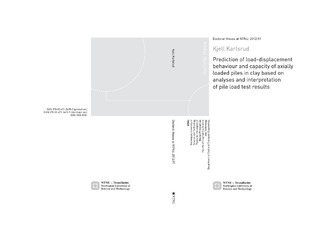| dc.contributor.author | Karlsrud, Kjell | nb_NO |
| dc.date.accessioned | 2014-12-19T11:28:16Z | |
| dc.date.available | 2014-12-19T11:28:16Z | |
| dc.date.created | 2012-08-08 | nb_NO |
| dc.date.issued | 2012 | nb_NO |
| dc.identifier | 543448 | nb_NO |
| dc.identifier.isbn | 978-82-471-3470-2 (printed ver.) | nb_NO |
| dc.identifier.isbn | 978-82-471-3471-9 (electronic ver.) | nb_NO |
| dc.identifier.uri | http://hdl.handle.net/11250/232007 | |
| dc.description.abstract | The main objective of the work presented herein was to develop new semi-empirical design procedures for determination of bearing capacity and load-displacement response of axially loaded piles in clay. Hereunder also prediction of how the capacity will build up with time following the pile installation, primarily as a result of consolidation.
A main basis for developing new procedures was the collection, detailed review and assessment of results from a series test programs carried out over the past 30 years on well instrumented piles. The data collected and reviewed include the pile installation, re-consolidation, and loading phases. The pile instrumentation includes measurement of the distribution of loads or shaft friction, pore pressure and earth pressure along the pile shafts. The soil conditions range from soft NC clays with undrained shear strength down to about 15 kPa, to very stiff and high OCR clays with undrained shear strength up to about 500 kPa. The plasticity index of the clays mostly lies in range 10 to 60 %. The test piles range from small scale model piles with diameter down to 36 mm and length down to 1- 2 m, to large scale piles with diameter up to 800 mm and length up 71 m. In addition to these fully instrumented pile tests, some recent large scale tests on non-instrumented piles are also reviewed and included as basis for developing the new proposed design procedures.
Two new procedures for predicting ultimate shaft friction are proposed, respectively a so-called α- and β approach. They tie the local ultimate shaft friction along a pile to the “true” undisturbed in-situ undrained strength of the clay as determined from Direct Simple Shear Tests, the in-situ vertical effective stress, the overconsolidation ratio, and the plasticity index of the clay.
No clear evidence is found of effects of pile diameter, length or stiffness on the local ultimate shaft friction, or whether the pile is open-or closed- ended. A moderate effect of pile length or flexibility on the total ultimate pile capacity will still come out of the proposed t-z curves, which include some postpeak reduction.
A brief review and summary is also given of measured effects of cyclic loads on the axial capacity and pile head displacements of piles. It is concluded that this issue can be well accounted for by analytical or numerical procedures already in existence.
A semi – empirical analytical procedure, based on linear radial consolidation theory, is proposed for predicting the time required for re-consolidation and “set-up” of the ultimate shaft friction. The main input parameters are the in-situ permeability and virgin modulus number (or virgin compression index) of the undisturbed clay. The same basic formula and correlations were found applicable to both open- and closed- ended or partially plugging piles. For design purposes it is very important to recognise that the time for full set-up can easily be a factor of 10 longer for a closed– ended pile than for an ideal nonplugging open- ended pile.
It was also an objective to study how well the measured pile response during installation, re-consolidation and pile loading could be predicted from analytical and numerical models. Although such procedures can give very valuable insight, there is still a way to go before they can correctly capture all relevant elements of the pile response. The greatest need for improvement is to establish a better understanding of how the severe disturbance and strains induced by the pile installation affects the basic stress-strain, strength-, and volumetric compressibility- characteristics of the clay, depending on the level of induced shear strains as function of radial distance from the pile wall. | nb_NO |
| dc.language | eng | nb_NO |
| dc.publisher | Norges teknisk-naturvitenskapelige universitet, Fakultet for ingeniørvitenskap og teknologi, Institutt for bygg, anlegg og transport | nb_NO |
| dc.relation.ispartofseries | Doktoravhandlinger ved NTNU, 1503-8181; 2012:97 | nb_NO |
| dc.title | Prediction of load-displacement behaviour and capacity ofaxially loaded piles in clay based on analyses and interpretation of pile load test results | nb_NO |
| dc.type | Doctoral thesis | nb_NO |
| dc.contributor.department | Norges teknisk-naturvitenskapelige universitet, Fakultet for ingeniørvitenskap og teknologi, Institutt for bygg, anlegg og transport | nb_NO |
| dc.description.degree | Dr.philos | nb_NO |
| dc.description.degree | Dr.philos | en_GB |
